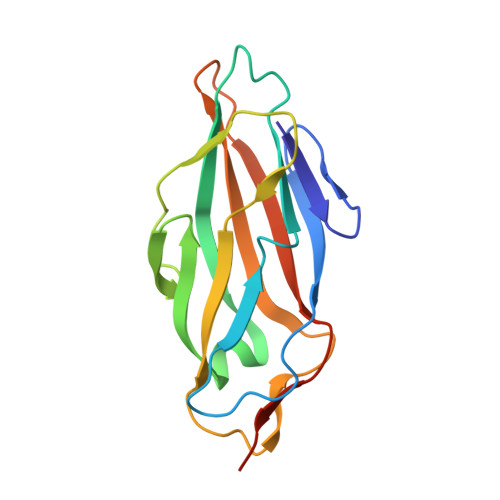Receptor binding studies disclose a novel class of high-affinity inhibitors of the Escherichia coli FimH adhesin
Bouckaert, J., Berglund, J., Schembri, M., De Genst, E., Cools, L., Wuhrer, M., Hung, C.S., Pinkner, J., Slattegard, R., Zavialov, A., Choudhury, D., Langermann, S., Hultgren, S.J., Wyns, L., Klemm, P., Oscarson, S., Knight, S.D., De Greve, H.(2005) Mol Microbiol 55: 441-455
- PubMed: 15659162
- DOI: https://doi.org/10.1111/j.1365-2958.2004.04415.x
- Primary Citation of Related Structures:
1TR7, 1UWF - PubMed Abstract:
Mannose-binding type 1 pili are important virulence factors for the establishment of Escherichia coli urinary tract infections (UTIs). These infections are initiated by adhesion of uropathogenic E. coli to uroplakin receptors in the uroepithelium via the FimH adhesin located at the tips of type 1 pili. Blocking of bacterial adhesion is able to prevent infection. Here, we provide for the first time binding data of the molecular events underlying type 1 fimbrial adherence, by crystallographic analyses of the FimH receptor binding domains from a uropathogenic and a K-12 strain, and affinity measurements with mannose, common mono- and disaccharides, and a series of alkyl and aryl mannosides. Our results illustrate that the lectin domain of the FimH adhesin is a stable and functional entity and that an exogenous butyl alpha-D-mannoside, bound in the crystal structures, exhibits a significantly better affinity for FimH (Kd = 0.15 microM) than mannose (Kd = 2.3 microM). Exploration of the binding affinities of alpha- d-mannosides with longer alkyl tails revealed affinities up to 5 nM. Aryl mannosides and fructose can also bind with high affinities to the FimH lectin domain, with a 100-fold improvement and 15-fold reduction in affinity, respectively, compared with mannose. Taken together, these relative FimH affinities correlate exceptionally well with the relative concentrations of the same glycans needed for the inhibition of adherence of type 1 piliated E. coli. We foresee that our findings will spark new ideas and initiatives for the development of UTI vaccines and anti-adhesive drugs to prevent anticipated and recurrent UTIs.
Organizational Affiliation:
Laboratorium voor Ultrastructuur, Vrije Universiteit Brussel and Vlaams Interuniversitair Instituut voor Biotechnologie, Building E, Pleinlaan 2, 1050 Brussels, Belgium.

















